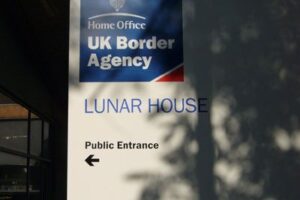UK Border Agency Digitization Transformation Success
Reprinted with permission from Genus Group, a Crowley UK – formerly referred to as Wicks and Wilson – reseller. Originally posted in 2016, this case study features the InoTec 4×3 document scanner series and the 8850 microfilm scanners, which have since been replaced by the InoTec 300-Series scanners and the Mekel Technology microfilm scanners, respectively.
Genus is delighted to report on a successful project recently undertaken by the UK Border Agency at its Landing Card Unit (LCU), based in Croydon. Involving production digitization hardware from both document capture and micrographic sectors, the project has seen a dramatic improvement in the operational efficiency of the unit.

BACKGROUND
The LCU, managed by Michael Walker and with a team of 12 people, helps to promote the collection, provision and best use of high quality biometric and biographic information to assure, identify and, support robust decision making and improve compliance. The LCU:
- Manages the non-controlled landing cards on behalf of Gatwick and Heathrow Airports and control cards for all ports
- Provides a full copy request service of landing cards to relevant parties
- Provides full management information to Migration Statistics on arriving passengers
With the UK Border Agency’s current transition to the Home Office (HO) – the LCU’s processes are linked directly to, and play a key part in, delivering the HO’s priorities on control, quality and cost.
ISSUES FACED BY THE LCU
- Slow retrieval times
- Aging equipment
- Image output quality
- Document scanner misfeeds and jams
- Large volume of 25 million historic landing card images
The unit receives approximately 350-400 requests per week for copies of landing cards from key stakeholders, including ports and police forces.
Historically landing cards had been filmed and stored in microfilm cartridges for retrieval but retrieval itself was time-consuming and reliant on aging equipment which produced poor quality output and required frequent maintenance intervention.
This provided huge unseen costs in the management of the 25 million historic data cards. More recent landing cards were captured digitally on a document scanner, but this was ill-equipped for the scanning of the challenging landing cards, which are heavily textured and of industrial weight and would frequently jam or misfeed, creating downtime and inefficiency.
SOLUTIONS
Having recently obtained the contract for the on-site maintenance of the unit’s document management equipment, Genus was consulted by the LCU on options to develop their digitization strategy. Having wide experience of supply and integration of both microfilm and document scanners, Genus was able to provide a complete solution to replace and improve on the existing processes. It focused on the implementation of two key pieces of high volume-production hardware.
HARD COPY DOCUMENT CAPTURE
The InoTec 4×3 Series is perfect for the digitization of high-volume and challenging materials such as the LCU cards and documents. Its glassless paper transport system, incredibly forgiving document feed system and unique belt transport system ensures downtime to misfeeds; jams and non-existent and LCU is able optimize its scanning output. The LCU staff have already reduced the backlog of landing cards to process to zero.
HISTORIC MICROFILM DOCUMENT CAPTURE
With over 25 million images on microfilm, a digitization unit capable of high-volume capture was required and Genus recommended the latest in high-volume production microfilm capture technology from Wicks and Wilson, for whom it distributes in the UK. A proof-of-concept trial on the 8850 Scanstation soon showed the superb imaging results and digitization speed of which the unit is capable and convinced the Border Agency to invest in the unit. The Nvidia GPU powered imaging software proved particularly adept at automated scanning of even the most challenging images on microfilm. Once Genus had installed the 8850, the LCU team immediately set to work in digitizing the historic data and have already completed the digitization of the 25m images, a superb achievement with far-reaching benefits.
BENEFITS
-
ACCESSIBILITY & SERVICE TO THE PUBLIC
LCU manager Michael Walker is rightly proud of his team’s achievement commenting, “The direct benefit to the business of the transfer of this data is that copies of landing cards are now accessible in a new format that does not degrade through use.” The Border Agency is a highly visible department of the Home Office and Walker adds “our customers and stakeholders have benefited from the improved service level and the public benefit from this as law enforcement agencies will now be able to access information on potential immigration abuse subjects that they would not have been able to previously. The effects of this digital transformation will continue to be felt over time.”
-
FINANCIAL SAVING
As with any government project, the Border Agency needed to be sure of a clear return on investment and the LCU can already point to immediate cost-savings through implementation of the InoTec and Wicks and Wilson scanners, benefiting from a much more efficient use in time. According to Michael Walker, “the changes to the process have saved the business money in terms of deployed resource and staff efficiencies have also been implemented.”
-
ENGAGEMENT WITH DIGITAL AGENDA
The injection of new digital hardware has also had the welcome benefit of inspiring the staff. Walker comments, “The unit has reacted positively to the move to the new process, the staff being provided with the opportunity to engage fully with the digital agenda and refreshing their outlook on what can be a routine role.”
Genus would like to thank Michael Walker, Lourdes Leitao and Danielle Killick for their assistance and input into this project.
